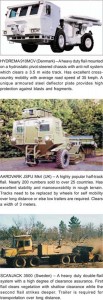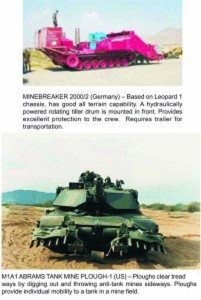Flails are the most widely used and the oldest mechanical system. Although they were first used during World War I, their development has been slow. It is only during the last decade that major efforts have been put in to refine them further.
 Flails have some major limitations. They are bulky, costly and guzzle fuel. There are many cases of mines being left broken or unexploded or even being thrown far away from their original placement. Their effectiveness in rocky soil is suspected. In dry conditions, the chains create dense clouds of dust. Still, most people consider the flail to be an indispensable part of all major demining programmes, especially in foliated areas. Hydrema 910 MCV and Aardvark JFSU flails are the most popular machines with demining community. Scanjack 3500 is a heavy duty double-flail machine which has also performed well in humanitarian demining tasks.
Flails have some major limitations. They are bulky, costly and guzzle fuel. There are many cases of mines being left broken or unexploded or even being thrown far away from their original placement. Their effectiveness in rocky soil is suspected. In dry conditions, the chains create dense clouds of dust. Still, most people consider the flail to be an indispensable part of all major demining programmes, especially in foliated areas. Hydrema 910 MCV and Aardvark JFSU flails are the most popular machines with demining community. Scanjack 3500 is a heavy duty double-flail machine which has also performed well in humanitarian demining tasks.
Trawls/Rollers/Tillers
Systems employing one or more hydraulically operated rotating horizontal drums with special metal spikes or teeth are referred to as trawls or rollers or tillers. They are designed to exert pressure to detonate or break up mines. They are heavy, difficult to transport and their operative costs are prohibitive. They have the capacity to till soil up to a depth of 50 centimeters and are fairly effective except on undulating, rocky and heavily vegetated areas.
Rollers can either be mounted on a prime mover or else be pushed/towed by another vehicle. They are particularly useful for breaching passages through minefields or for proofing unmetalled roads. Germany’s Mine Breaker 2002/2 with tiller drum is being widely used.
Ploughs
They are used for individual mobility of a vehicle (generally armoured) through a minefield. An attachment with ploughing teeth is fitted in front of the vehicle at a slant. The teeth dig out mines while the slant throws them sideways, thereby clearing the tread way of the vehicle. Ploughs are commonly used by assaulting armoured columns.
Combination Machines
A number of combination machines incorporating various aspects of diverse techniques are also under development to increase assurance level. KMT 7 combines rollers and plough techniques to clear full tank width with enhanced assurance over the cleared passage.
Recent Developments in Demining Machines
Initially demining machines were developed purely for military purposes. They are designed to clear only a navigable path through a mine field. For such machines, the prime considerations are speed of clearance, safety of operators, self-mobility to keep pace with advancing columns and ruggedness to withstand hostile operational environment.
A great deal of research is yet to be carried out to fully understand soil behaviour under stress of flails, tillers and rollers as that causes shifting of mines and affects their subsequent destruction.
Subsequently they were modified and used for humanitarian demining, though their effectiveness in area clearance remains suspect. Military depends primarily on ‘mechanical demining’, whereas for humanitarian purposes it is always ‘mechanically assisted demining’. The mechanical methodology by itself cannot provide the required clearance assurance as yet. Additionally, the present crop of military machines is not environment friendly.
Humanitarian demining has been providing the necessary momentum for advances in demining technology over the last decade. Efforts are being made to develop machines with better mine clearance assurance with speed and safety. Cost of demining also continues to be major consideration.





